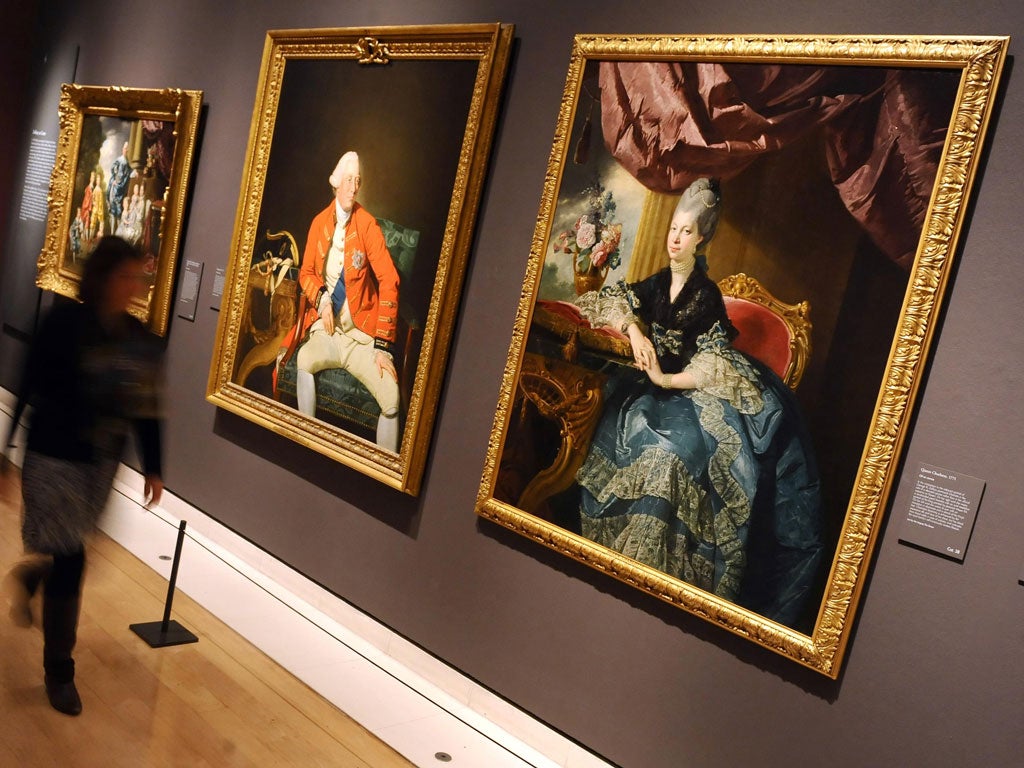Johan Zoffany RA: Society Observed, Royal Academy, London
A German-born observer of British society is eclipsed today by Gainsborough and Reynolds, but his pictures, decoded, are revealing

Was there ever a more ill-matched pair than George III and Queen Charlotte? I do not mean the royal couple themselves – as their marriage produced 15 children, we can assume that it was fond at the very least – but their portraits by Zoffany, in the show of his work at the Royal Academy.
On the left, the king, hefty, Hanoverian, not yet mad, with the wide-legged posture of a man in a pub. The trappings of George's kingship – his general's tricorne hat and sword – have been tossed aside, his Garter star is skew-whiff. The picture's austere background and ami du peuple pose seem almost republican. It would be interesting to see it next to Boilly's portrait of Robespierre, painted 20 years later.
By contrast, Charlotte is resolutely ancien régime, all taffeta and lace, the queen paired with a vase (gilt, naturally) of peonies. The flavour here is of Vigée Le Brun's 30 portraits of Marie Antoinette, the bosom friend of Charlotte whose murder in 1793 would shake the English queen to the core. What seems strange is not just that this domestic couple – Mr and Mrs King, as they called each other – should have been portrayed so very differently, but that they were painted in the same year (1771) and by the same man.
Particularly so because that man is Johan Zoffany, known to us in Britain as John. I can't remember the last Zoffany show I went to; actually, I can't remember having ever been to a Zoffany show at all. Eclipsed by home-grown rivals such as Gainsborough and Reynolds, the Frankfurt-born painter has languished in the critical shadows for decades. Too Classical, we say, too German; a creature of the Establishment, of academies and courts and clubs – an impression apparently confirmed by the title of this show, Johan Zoffany RA: Society Observed.
But not quite. Around the corner from the Kings is the kind of picture we think of as typically Zoffany-esque, The Tribuna of the Uffizi. A huge, 20-square-metre record of the Uffizi's Tribuna room, the picture is meticulous, exact. Commissioned by Queen Charlotte, it shows two dozen English Grand Tourists and diplomats poring over a similar number of works in the Florentine gallery's collection. Zoffany slaved over this conversation piece for six years. Every canvas in the picture can be identified, and all but one of the men: among them, the Hon Felton Hervey, the Earl of Winchilsea, Sir John Dick and Thomas Patch, Esq. Last, but not at all least, there is a portrait of Johan Zoffany.
It is easy to mistake The Tribuna of the Uffizi for something it is not. Painting minute but perfect versions of works by other artists – Raphael's Madonna of the Goldfinch, Rubens's Justus Lipsius and his Pupils – seems slavish. It also seems like cheating, as though Zoffany, in appropriating the art of these great painters, is suggesting that he is one of their number. So, too, with the inclusion of himself among the bon ton of Anglo-Florentine society. To put not too fine a point on it, Zoffany seems less like an observer of society than an endorser of it, a social climber, a crawler to the great and good.
Two things militate against this view, the one allied to the other. When, in 1779, Zoffany finally presented his conversation piece to Queen Charlotte, that eagle-eyed consort did not like what she saw. In the 21st century, we find The Tribuna of the Uffizi over-ordered, academic, a study of rich men and their cultural possessions. Charlotte, by contrast, saw subversion.
Right in the foreground of Zoffany's picture, much to the interest of the men around it, is Titian's erotically charged Venus of Urbino. That is bad enough, but there was worse. The picture seems of little interest to the man holding its top right-hand corner, who points instead to the muscular arses of Hellenistic youths wrestling in marble. That man, Thomas Patch, was an English painter who had been forced to leave Rome because of his homosexual dalliances. Charlotte was appalled at Patch's inclusion, as she was at the work as a whole. Beneath its apparent recording of the social status quo was an encrypted life of naughtiness, sexuality, animalism. What seemed like an ordered society was actually a society on the point of falling apart, a civilisation of discontents. In 1777, the year after Britain's North American colonies had declared themselves independent, it was not a world view likely to appeal to the wife of a king. Zoffany never worked for the royal family again.
Near this large work is another, much smaller one, a self-portrait by Zoffany as a monk. Tacked to the wall behind him are a pair of cat-gut condoms – possibly the first representation of contraceptives in history, according to the show's curator. On the picture's obverse side, shockingly, is a Flight into Egypt.
This is a very different Zoffany from the one we thought we knew, although that is largely because, in the past century or so, we haven't much bothered to look. So now's the time. See this excellent show if you can.
Royal Academy, London W1 (020- 7300 8000) to 10 June
Art choice
Alighiero Boetti has a game plan that consists of witty self-portraits, embroidered maps, works in ballpoint ... see it at Tate Modern, London to 27 May. Piet Mondrian is better known than Ben Nicholson, but an exhibition at London's Courtauld (to 20 May) placing the friends' work side by side, is revealing.
Subscribe to Independent Premium to bookmark this article
Want to bookmark your favourite articles and stories to read or reference later? Start your Independent Premium subscription today.

Join our commenting forum
Join thought-provoking conversations, follow other Independent readers and see their replies